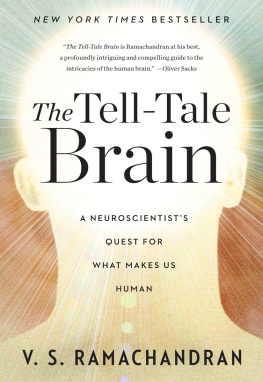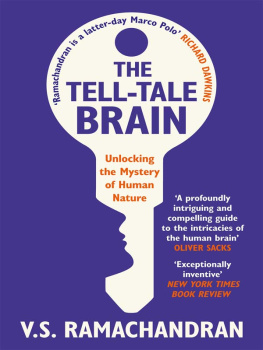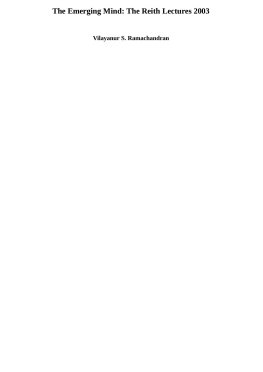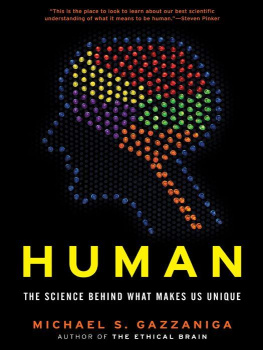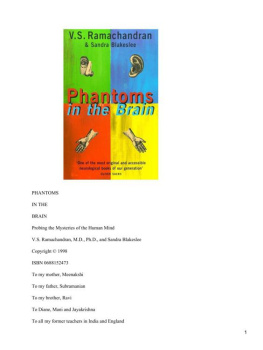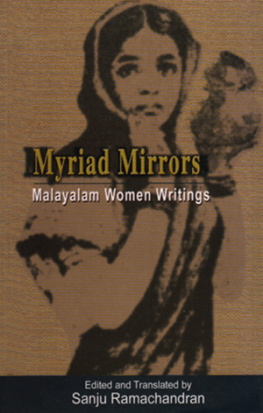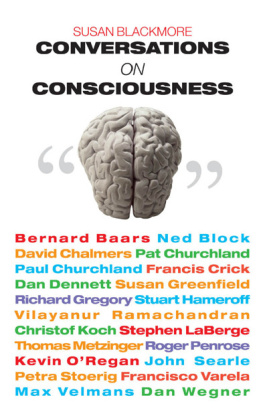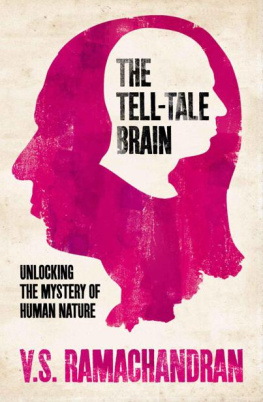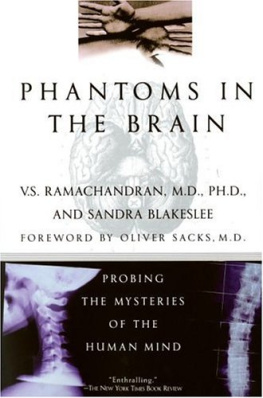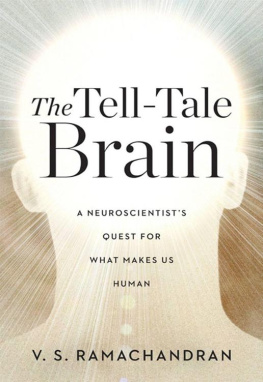V. S. RAMACHANDRAN
The
TELL-TALE BRAIN

A Neuroscientists Quest for What Makes Us Human
V. S. RAMACHANDRAN
W. W. NORTON & COMPANY
NEW YORK LONDON
Copyright 2011 by V. S. Ramachandran
All rights reserved
Figure 7.1: Illustration from Animal Architecture by Karl von Frisch and Otto von Frisch, illustrations copyright 1974 by Turid Holldobler, reprinted by permission of Harcourt, Inc.
For information about permission to reproduce selections from this book, write to Permissions, W. W. Norton & Company, Inc., 500 Fifth Avenue, New York, NY 10110
Library of Congress Cataloging-in-Publication Data
Ramachandran, V. S.
The tell-tale brain: a neuroscientists quest for what makes us human/
V. S. Ramachandran.1st ed.
p. cm.
Includes bibliographical references.
ISBN 978-0-393-07782-7 (hardcover)
1. NeurosciencesPopular works. 2. NeurologyPopular works. 3. BrainPopular works. I. Title.
RC351.A45 2011
616.8dc22
2010044913
W. W. Norton & Company, Inc.
500 Fifth Avenue, New York, N.Y. 10110
www.wwnorton.com
ISBN: 978-0-393-08058-2 (e-book)
W. W. Norton & Company Ltd.
Castle House, 75/76 Wells Street, London W1T 3QT
For my mother, V. S. Meenakshi, and
my father, V. M. Subramanian
For Jaya Krishnan, Mani, and Diane
And for my ancestral sage Bharadhwaja,
who brought medicine down from the gods to mortals
CONTENTS
PREFACE
There is not, within the wide range of philosophical inquiry, a subject more intensely interesting to all who thirst for knowledge, than the precise nature of that important mental superiority which elevates the human being above the brute
EDWARD BLYTH
F OR THE PAST QUARTER CENTURY I HAVE HAD THE MARVELOUS privilege of being able to work in the emerging field of cognitive neuroscience. This book is a distillation of a large chunk of my lifes work, which has been to unravelstrand by elusive strandthe mysterious connections between brain, mind, and body. In the chapters ahead I recount my investigations of various aspects of our inner mental life that we are naturally curious about. How do we perceive the world? What is the so-called mind-body connection? What determines your sexual identity? What is consciousness? What goes wrong in autism? How can we account for all of those mysterious faculties that are so quintessentially human, such as art, language, metaphor, creativity, self-awareness, and even religious sensibilities? As a scientist I am driven by an intense curiosity to learn how the brain of an apean ape!managed to evolve such a godlike array of mental abilities.
My approach to these questions has been to study patients with damage or genetic quirks in different parts of their brains that produce bizarre effects on their minds or behavior. Over the years I have worked with hundreds of patients afflicted (though some feel they are blessed) with a great diversity of unusual and curious neurological disorders. For example, people who see musical tones or taste the textures of everything they touch, or the patient who experiences himself leaving his body and viewing it from above near the ceiling. In this book I describe what I have learned from these cases. Disorders like these are always baffling at first, but thanks to the magic of the scientific method we can render them comprehensible by doing the right experiments. In recounting each case I will take you through the same step-by-step reasoningoccasionally navigating the gaps with wild intuitive hunchesthat I went through in my own mind as I puzzled over how to render it explicable. Often when a clinical mystery is solved, the explanation reveals something new about how the normal, healthy brain works, and yields unexpected insights into some of our most cherished mental faculties. I hope that you, the reader, will find these journeys as interesting as I did.
Readers who have assiduously followed my whole oeuvre over the years will recognize some of the case histories that I presented in my previous books, Phantoms in the Brain and A Brief Tour of Human Consciousness . These same readers will be pleased to see that I have new things to say about even my earlier findings and observations. Brain science has advanced at an astonishing pace over the past fifteen years, lending fresh perspectives onwell, just about everything. After decades of floundering in the shadow of the hard sciences, the age of neuroscience has truly dawned, and this rapid progress has directed and enriched my own work.
The past two hundred years saw breathtaking progress in many areas of science. In physics, just when the late nineteenth-century intelligentsia were declaring that physical theory was all but complete, Einstein showed us that space and time were infinitely stranger than anything formerly dreamed of in our philosophy, and Heisenberg pointed out that at the subatomic level even our most basic notions of cause and effect break down. As soon as we moved past our dismay, we were rewarded by the revelation of black holes, quantum entanglement, and a hundred other mysteries that will keep stoking our sense of wonder for centuries to come. Who would have thought the universe is made up of strings vibrating in tune with Gods music? Similar lists can be made for discoveries in other fields. Cosmology gave us the expanding universe, dark matter, and jaw-dropping vistas of endless billions of galaxies. Chemistry explained the world using the periodic table of the elements and gave us plastics and a cornucopia of wonder drugs. Mathematics gave us computersalthough many pure mathematicians would rather not see their discipline sullied by such practical uses. In biology, the anatomy and physiology of the body were worked out in exquisite detail, and the mechanisms that drive evolution finally started to become clear. Diseases that had literally plagued humankind since the dawn of history were at last understood for what they really were (as opposed to, say, acts of witchcraft or divine retribution). Revolutions occurred in surgery, pharmacology, and public health, and human life spans in the developed world doubled in the space of just four or five generations. The ultimate revolution was the deciphering of the genetic code in the 1950s, which marks the birth of modern biology.
By comparison, the sciences of the mindpsychiatry, neurology, psychologylanguished for centuries. Indeed, until the last quarter of the twentieth century, rigorous theories of perception, emotion, cognition, and intelligence were nowhere to be found (one notable exception being color vision). For most of the twentieth century, all we had to offer in the way of explaining human behavior was two theoretical edificesFreudianism and behaviorismboth of which would be dramatically eclipsed in the 1980s and 1990s, when neuroscience finally managed to advance beyond the Bronze Age. In historical terms that isnt a very long time. Compared with physics and chemistry, neuroscience is still a young upstart. But progress is progress, and what a period of progress it has been! From genes to cells to circuits to cognition, the depth and breadth of todays neurosciencehowever far short of an eventual Grand Unified Theory it may beis light-years beyond where it was when I started working in the field. In the last decade we have even seen neuroscience becoming self-confident enough to start offering ideas to disciplines that have traditionally been claimed by the humanities. So we now for instance have neuroeconomics, neuromarketing, neuroarchitecture, neuroarchaeology, neurolaw, neuropolitics, neuroesthetics (see Chapters 4 and 8), and even neurotheology. Some of these are just neurohype, but on the whole they are making real and much-needed contributions to many fields.

